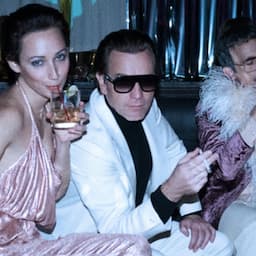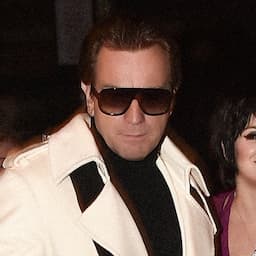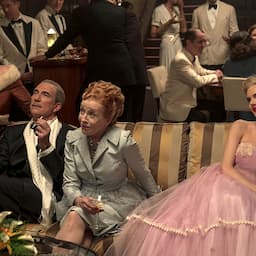ET looks back on interviews with the American fashion designer as he discusses his career.
Known simply as Halston, Roy Halston Frowick was an American fashion designer who rose to prominence in the 1960s before going on to define the Studio 54 era of the ‘70s and early ‘80s until he lost control of his fashion house.
During that time, Jacqueline Kennedy famously wore one of Halston’s pillbox hats to husband John F. Kennedy’s 1961 presidential inauguration. The designer then went on to become head milliner for the high-end department store Bergdorf Goodman, before making the transition into women’s clothing and launching his own boutique business and ready-to-wear line.
Thanks to the creation of ultrasuede and his use of cashmere, Halston went on to redefine women’s apparel and through various partnerships, became a staple of American fashion. He also was at the center of the social life in New York City, often seen at Studio 54 with his allegiance of celebrity friends, including Liza Minnelli, Andy Warhol and others.
By the late ‘80s, however, Halston lost control of his business -- and most notably the right ever to design under his own name -- and eventually moved to the West Coast, where he lived until his death of AIDS-related causes at the age of 57.
The ups and downs of the designer’s career and his impact on the fashion industry have been chronicled in the 2019 documentary Halston, and the 1991 biography Simply Halston: The Untold Story by Steven Gaines. Additionally, his story is being retold by Ryan Murphy in the biographical Netflix limited series Halston, with Ewan McGregor portraying the famed personality.
As people dig into his story, ET revisited several interviews conducted with Halston between 1982 and 1987 as he recounted highlights of his life and career. Here’s Halston in his own words.
On coming to New York City:
“Oh, New York in 1957 was the most terrific place I'd ever seen. I was a young man when I first came to New York and it was the land of fantasy, style, beauty, glamour, safety, everything. All day and all night.
“It was just the most wonderful place I'd ever been in life. I came from the midwest and coming to New York was just like the land of opportunity. It was the dream that I was always wanting and it was finally fulfilled.”
On dressing Jackie O:
“The hairstyles were rather short and a wavy kind of bob. And women wore hats. So, you know, they wore hats every day. And hats were very much the fashion, so women might have, oh, 20 hats a season or something like that. And there'd be fewer suits or dresses or things, but people wore hats to cover up the hairdo. So you had to accommodate the hat. That was part of the fashion. It seems so strange now, but it's not so long ago, when Jackie O or Kennedy was in the White House. You know, she wore a hat every day. A different one in the day, a different one in the afternoon.”
“I remember Mrs. Onassis, who was Mrs. Kennedy in those days, came to me and wanted to look like a woman on the street. She didn't want to look like Mrs. Kennedy. And she came and we made her an enormous wardrobe of things. Just sweaters and pants and trench coats and scarves and that sort of thing. So, she would look rather simple and walk down the street without being noticed.”
On working at Bergdorf Goodman:
“I always wanted to change everything in clothing. To make it a little more simple. To make it a little more American. To make it more contemporary and newer. And always a point of difference. And that's the only thing that makes a designer become important. And that it was always that challenge to change the mood of fashion. And that's really the only way you create a style. And that you have a signature.
“I started to work at Bergdof Goodman in New York and we sold to all the major stores across the country, which is something that they hadn't done before. We had stores in California, in the midwest, in the south, and so forth and so on. The better specialty stores.”
On the launch of his first ready-to-wear line:
“I opened my own business in 1968, at 68th and Madison. It was the corner building there. And it just grew and grew and grew and grew. Until it got too big and then I moved to the Olympic Tower.
“[It] was very relaxed. It was fashion to bridge the gap between the very fancy end of the fashion business -- the whole couture for lack of a better word -- and the ready-to-wear things. So people could look, you know, very interesting or look like they had some quality clothing on. And look different than the average couture client. Or the average ready-to-wear client. It was very special. It was like you were the only one that had it. I tell you, people just stood in line to buy it. It was a really great success. Really.”
On his celebrity clientele:
“[A designer is] only as good as the people who, in fact, buy what you produce. Because the end result, the client makes it fashionable. In other words, if somebody who lives in the public eye wears your things, it [brings] attention to him. And perhaps other people might want to look that way. Or if the secretary looks good in something, her friends might ask her. That's the way fashion is made. Not through the press. Not through designers or anything else. It's made through people.
“I think it's very important [to have celebrity clients] because I think they [bring] attention to you and your product. And if they look good in it, and people talk about it -- I've always had a big, known clientele on all different levels, and it has always, always helped the business… Like Liza Minnelli. Or Elizabeth Taylor. Or Lauren Bacall. Farrah Fawcett. Or somebody like that really people notice and talk about.”
On socializing:
“I think you become friends through business, you know, or whatever it is. You become friends, because you're friends. Simply.”
“I go to parties, like, I'm going to one tonight that Diana Vreeland invited me to. Her 90th birthday for [legendary Russian illustrator] Erte. And it -- I'm going for her and I'm going for him out of respect and because I want to go. But I very rarely go to parties.
“Most of [my friends] are writers. Or artists. Or actresses. Or people in the arts. You know, like, a Martha Graham, who is one of my best friends ever in life. And Andy Warhol. Liza. Or whoever it might be.”
On licensing his name:
“It's helped me help myself. It was something that I needed very, very much. At that particular point in my career, because my business was growing so very fast, I wasn't able to do all of the legal obligations and the financial aspects of the business and I needed a larger corporate structure to help me out. So, it really helped me help myself, it freed me to do more, which I was able to do.
“[JCPenney] is a public company. We just had our stockholders meeting this morning. We all have to sign in for a six-month program, a year program, a five-year program. Everything else. And if I meet the goals of a public company, it's very interesting and I think a healthy challenge.
“It hasn't been a problem so far. I'm quite a good producer of revenue.
“I think it only enhances the Halston name. To reach a broader public is a much more interesting challenge -- than to reach a few.”
RELATED CONTENT:


